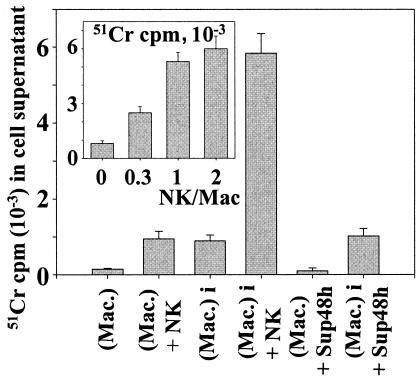FIG. 7.
Cytotoxicity of NK cells against infected macrophages. A total of 8 × 105 macrophages in 24-well plates were first labeled with 25 μCi of radioactive 51Cr as indicated in Materials and Methods. They were then infected (Mac-i) or not (Mac) with B. suis (MOI = 20) and cultured in the presence (Mac-i/NK and Mac/NK, respectively) or absence (Mac and Mac-i, respectively) of 8 × 105 NK cells (macrophage/NK cell ratio = 1) for a further 48 h in 1 ml of RPMI-FCS-gentamicin. 51Cr-labeled macrophages were also cultured in the presence of 500 μl of Sup48h (supernatants of 48 -h cocultures of B. suis-infected macrophages with autologous NK cells [Fig. 4]) (Mac-i/Sup48h and Mac/Sup48h, respectively) in the presence of gentamicin (conditions of Fig. 4). The cell supernatants were then harvested and filtered. Macrophage lysis was estimated by measuring the radioactivity (51Cr released) present in cell supernatants. For the insert, 8 × 105 infected 51Cr-labeled macrophages were cultured for 48 h in the presence of various amounts of syngeneic NK cells, and radioactivity in cell supernatants was then measured. The y axis shows radioactivity in cell supernatant; the x axis shows number of NK cells per number of macrophages in the assay. Control measurement revealed that macrophages incorporated 8.23 × 105 ± 1.11 × 105 cpm of 51Cr/well. For each determination, 51Cr release was the mean from triplicate wells, four experiments being performed. Error bars, SEMs for four different experiments.

